Preparation of Superhydrophobic Surface on Titanium Alloy via Micro-Milling, Anodic Oxidation and Fluorination
Abstract
:1. Introduction
2. Materials and Methods
2.1. Preparation of Microgrooves via Micro-Milling
2.2. Construction of TiO2 Nanotubes via Anodic Oxidation
2.3. Fluorination on the Surface with Micro/Nanostructure
2.4. Specimen Characterization
2.5. Surface Wettability
3. Results and Discussion
3.1. Surface Morphologies
3.2. Surface Chemical Composition
3.3. Surface Wettability
4. Conclusions
Author Contributions
Funding
Conflicts of Interest
References
- Zhang, K.; Liu, T.; Li, J.A.; Chen, J.Y.; Wang, J.; Huang, N. Surface modification of implanted cardiovascular metal stents: From antithrombosis and antirestenosis to endothelialization. J. Biomed. Mater. Res. 2014, 102, 588–609. [Google Scholar] [CrossRef] [PubMed]
- Li, B.; Wang, X.; Min, Y.; Liang, C.; Li, H.; Guo, L.; Liu, S.; Wang, H. Corrosion resistance and mechanical properties of titanium with hierarchical micro-nanostructure. Mater. Lett. 2016, 182, 43–46. [Google Scholar] [CrossRef]
- Khorasani, A.M.; Goldberg, M.; Doeven, E.H.; Littlefair, G. Titanium in Biomedical Applications—Properties and Fabrication: A Review. J. Biomater. Tiss. Eng. 2015, 5, 593–619. [Google Scholar] [CrossRef]
- Zhang, L.; Attar, H. Selective Laser Melting of Titanium Alloys and Titanium Matrix Composites for Biomedical Applications: A Review. Adv. Eng. Mater. 2016, 18, 463–475. [Google Scholar] [CrossRef]
- Fu, J.; Su, Y.; Qin, Y.; Zheng, Y.; Wang, Y.; Zhu, D. Evolution of metallic cardiovascular stent materials: A comparative study among stainless steel, magnesium and zinc. Biomaterials 2020, 230, 119641. [Google Scholar] [CrossRef]
- Zhang, D.; Wang, L.; Qian, H.; Li, X. Superhydrophobic surfaces for corrosion protection: a review of recent progresses and future directions. J. Coat. Technol. Res. 2016, 13, 11–29. [Google Scholar] [CrossRef] [Green Version]
- Nishimoto, S.; Bhushan, B. Bioinspired self-cleaning surfaces with superhydrophobicity, superoleophobicity, and superhydrophilicity. RSC Adv. 2013, 3, 671–690. [Google Scholar] [CrossRef]
- Dai, S.; Zhang, D.; Shi, Q.; Han, X.; Wang, S.; Du, Z. Biomimetic fabrication and tunable wetting properties of three-dimensional hierarchical ZnO structures by combining soft lithography templated with lotus leaf and hydrothermal treatments. Crystengcomm 2013, 15, 5417. [Google Scholar] [CrossRef] [Green Version]
- Cai, Y.; Chang, W.; Luo, X.; Sousa, A.M.L.; Lau, K.H.A.; Qin, Y. Superhydrophobic structures on 316L stainless steel surfaces machined by nanosecond pulsed laser. Precis. Eng. 2018, 52, 266–275. [Google Scholar] [CrossRef] [Green Version]
- Wang, B.; Zhang, Y.; Shi, L.; Li, J.; Guo, Z. Advances in the theory of superhydrophobic surfaces. J. Mater. Chem. 2012, 22, 20112–20127. [Google Scholar] [CrossRef]
- Bartlet, K.; Movafaghi, S.; Dasi, L.P.; Kota, A.K.; Popat, K.C. Antibacterial activity on superhydrophobic titania nanotube arrays. Colloids Surf. B Biointerfaces 2018, 166, 179–186. [Google Scholar] [CrossRef] [PubMed]
- Hou, X.; Wang, X.; Zhu, Q.; Bao, J.; Mao, C.; Jiang, L.; Shen, J. Preparation of polypropylene superhydrophobic surface and its blood compatibility. Colloids Surf. B Biointerfaces 2010, 80, 247–250. [Google Scholar] [CrossRef] [PubMed]
- Patil, D.; Aravindan, S.; Kaushal Wasson, M.; Perumal, V.; Rao, P.V. Fast Fabrication of Superhydrophobic Titanium Alloy as Antibacterial Surface Using Nanosecond Laser Texturing. J. Micro Nano-Manuf. 2018, 6, 011002–011009. [Google Scholar] [CrossRef]
- Hasan, J.; Raj, S.; Yadav, L.; Chatterjee, K. Chatterjee. Engineering a nanostructured “super surface” with superhydrophobic and superkilling properties. RSC Adv. 2015, 5, 44953–44959. [Google Scholar] [CrossRef] [Green Version]
- Hosseinabadi, H.N.; Sajjady, S.A.; Amini, S. Creating micro textured surfaces for the improvement of surface wettability through ultrasonic vibration assisted turning. Int. J. Adv. Manuf. Tech. 2018, 96, 2825–2839. [Google Scholar] [CrossRef]
- Gao, X.; Tong, W.; Ouyang, X.; Wang, X. Facile fabrication of a superhydrophobic titanium surface with mechanical durability by chemical etching. RSC Adv. 2015, 5, 84666–84672. [Google Scholar] [CrossRef]
- Jaggessar, A.; Shahali, H.; Mathew, A.; Yarlagadda, P. Bio-mimicking nano and micro-structured surface fabrication for antibacterial properties in medical implants. J. Nanobiotechnol. 2017, 15, 64. [Google Scholar] [CrossRef] [Green Version]
- Huang, Q.; Elkhooly, T.A.; Liu, X.; Zhang, R.; Yang, X.; Shen, Z.; Feng, Q. Effects of hierarchical micro/nano-topographies on the morphology, proliferation and differentiation of osteoblast-like cells. Colloids Surf. B Biointerfaces 2016, 145, 37–45. [Google Scholar] [CrossRef]
- Mariscal-Muñoz, E.; Costa, C.A.S.; Tavares, H.S.; Bianchi, J.; Hebling, J.; Machado, J.P.B.; Lerner, U.H.; Souza, P.P.C. Osteoblast differentiation is enhanced by a nano-to-micro hybrid titanium surface created by Yb:YAG laser irradiation. Clin. Oral Investig. 2016, 20, 503–511. [Google Scholar] [CrossRef]
- Roach, P.; Shirtcliffe, N.J.; Newton, M.I. Progess in superhydrophobic surface development. Soft Matter. 2008, 4, 224–240. [Google Scholar] [CrossRef]
- Neinhuis, C.; Barthlott, W. Characterization and Distribution of Water-repellent, Self-cleaning Plant Surfaces. Ann. Bot.-Lond. 1997, 79, 667–677. [Google Scholar] [CrossRef] [Green Version]
- Mock, U.; Förster, R.; Menz, W.; Rühe, J. Towards ultrahydrophobic surfaces: a biomimetic approach. J. Phys. Condensed Matter. 2005, 17, S639–S648. [Google Scholar] [CrossRef] [Green Version]
- Gao, X.; Jiang, L. Water-repellent legs of water striders. Nature. 2004, 432, 36. [Google Scholar] [CrossRef] [PubMed]
- Rezayi, T.; Entezari, M.H. Toward a durable superhydrophobic aluminum surface by etching and ZnO nanoparticle deposition. J. Colloid Interface Sci. 2016, 463, 37–45. [Google Scholar] [CrossRef]
- Varshney, P.; Mohapatra, S.S.; Kumar, A. Superhydrophobic coatings for aluminium surfaces synthesized by chemical etching process. Int. J. Smart Nano Mater. 2016, 7, 248–264. [Google Scholar] [CrossRef] [Green Version]
- Jagdheesh, R.; Diaz, M.; Marimuthu, S.; Ocaña, J.L. Hybrid laser and vacuum process for rapid ultrahydrophobic Ti-6Al-4 V surface formation. Appl. Surf. Sci. 2019, 471, 759–766. [Google Scholar] [CrossRef]
- Li, J.; Xu, J.; Wang, B.; Guo, Z. Transparent and Superhydrophobic Co3O4 Microfiber Films. Chem. Lett. 2014, 43, 100–101. [Google Scholar] [CrossRef]
- Youngblood, J.P.; McCarthy, T.J. Ultrahydrophobic Polymer Surfaces Prepared by Simultaneous Ablation of Polypropylene and Sputtering of Poly (tetrafluoroethylene) Using Radio Frequency Plasma. Macromolecules 1999, 32, 6800–6806. [Google Scholar] [CrossRef]
- Brevnov, D.A.; Barela, M.J.; Brooks, M.J.; Lόpez, G.P.; Atanassov, P.B. Fabrication of Anisotropic Super Hydrophobic/Hydrophilic Nanoporous Membranes by Plasma Polymerization of C4F8 on Anodic Aluminum Oxide. J. Electrochem. Soc. 2004, 151, B484. [Google Scholar] [CrossRef]
- Yue, C.; Gao, H.; Liu, X.; Liang, S.Y.; Wang, L. A review of chatter vibration research in milling. Chin. J. Aeronaut. 2019, 32, 215–242. [Google Scholar] [CrossRef]
- Cai, Y.; Chang, W.; Luo, X.; Qin, Y. Hydrophobicity of pyramid structures fabricated by micro-milling. In Proceedings of the 2017 World Congress on Micro and Nano Manufacturing, Kaohsiung, Taiwan, 27–30 March 2017; pp. 1–4. [Google Scholar]
- Chen, Y.; Lu, W.; Guo, Y.; Zhu, Y.; Lu, H.; Wu, Y. Superhydrophobic coatings on gelatin-based films: fabrication, characterization and cytotoxicity studies. RSC Adv. 2018, 8, 23712–23719. [Google Scholar] [CrossRef] [Green Version]
- Sun, Y.; Wang, L.; Gao, Y.; Guo, D. Preparation of stable superamphiphobic surfaces on Ti-6Al-4V substrates by one-step anodization. Appl. Surf. Sci. 2015, 324, 825–830. [Google Scholar] [CrossRef]
- Gao, Y.; Sun, Y.; Guo, D. Facile fabrication of superhydrophobic surfaces with low roughness on Ti–6Al–4V substrates via anodization. Appl. Surf. Sci. 2014, 314, 754–759. [Google Scholar] [CrossRef]
- Jiang, J.Y.; Xu, J.L.; Liu, Z.H.; Deng, L.; Sun, B.; Liu, S.D.; Wang, L.; Liu, H.Y. Preparation, corrosion resistance and hemocompatibility of the superhydrophobic TiO2 coatings on biomedical Ti-6Al-4V alloys. Appl. Surf. Sci. 2015, 347, 591–595. [Google Scholar] [CrossRef]
- Wenzel, R.N. Resistance of solid surfaces to wetting by water. Ind. Eng. Chem. 1936, 28, 988–994. [Google Scholar] [CrossRef]
- Cassie, A.B.D.; Baxte, S. Wettability of porous surfaces. Trans. Faraday Soc. 1944, 40, 546–551. [Google Scholar] [CrossRef]
- Young, T. An essay on the cohesion of fluids. Philos. Trans. R. Soc. Lond. 1805, 95, 65–84. [Google Scholar]
- Extrand, C.W. A thermodynamic model for contact angle hysteresis. J. Colloid Interface Sci. 1998, 207, 11–19. [Google Scholar] [CrossRef]
- Rupp, F.; Gittens, R.A.; Scheideler, L.; Marmur, A.; Boyan, B.D.; Schwartz, Z.; Geis-Gerstorfer, J. A review on the wettability of dental implant surfaces I: theoretical and experimental aspects. Acta Biomater. 2014, 10, 2894–2906. [Google Scholar] [CrossRef] [Green Version]
- Roy, P.; Dey, T.; Schmuki, P. Scanning electron microscopy observation of nanoscopic wetting of TiO2 nanotubes and ODS modified nanotubes using ionic liquids. Electrochem. Solid-State Lett. 2010, 13, E11–E13. [Google Scholar] [CrossRef]
- Liang, J.; Song, R.; Huang, Q.; Yang, Y.; Lin, L.; Zhang, Y.; Jiang, P.; Duan, H.; Dong, X.; Lin, C. Electrochemical construction of a bio-inspired micro/nano-textured structure with cell-sized microhole arrays on biomedical titanium to enhance bioactivity. Electrochim. Acta. 2015, 174, 1149–1159. [Google Scholar] [CrossRef]

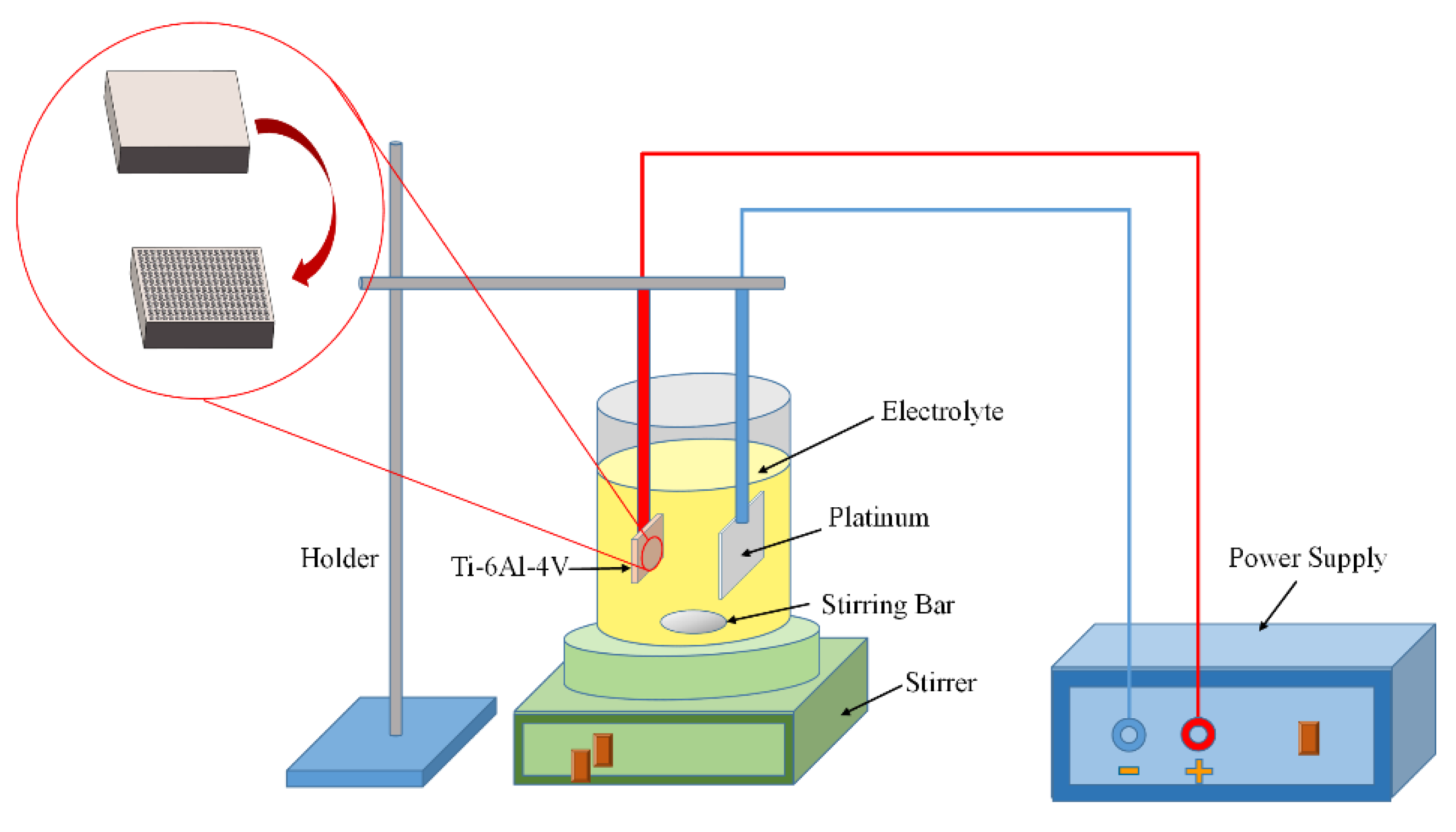
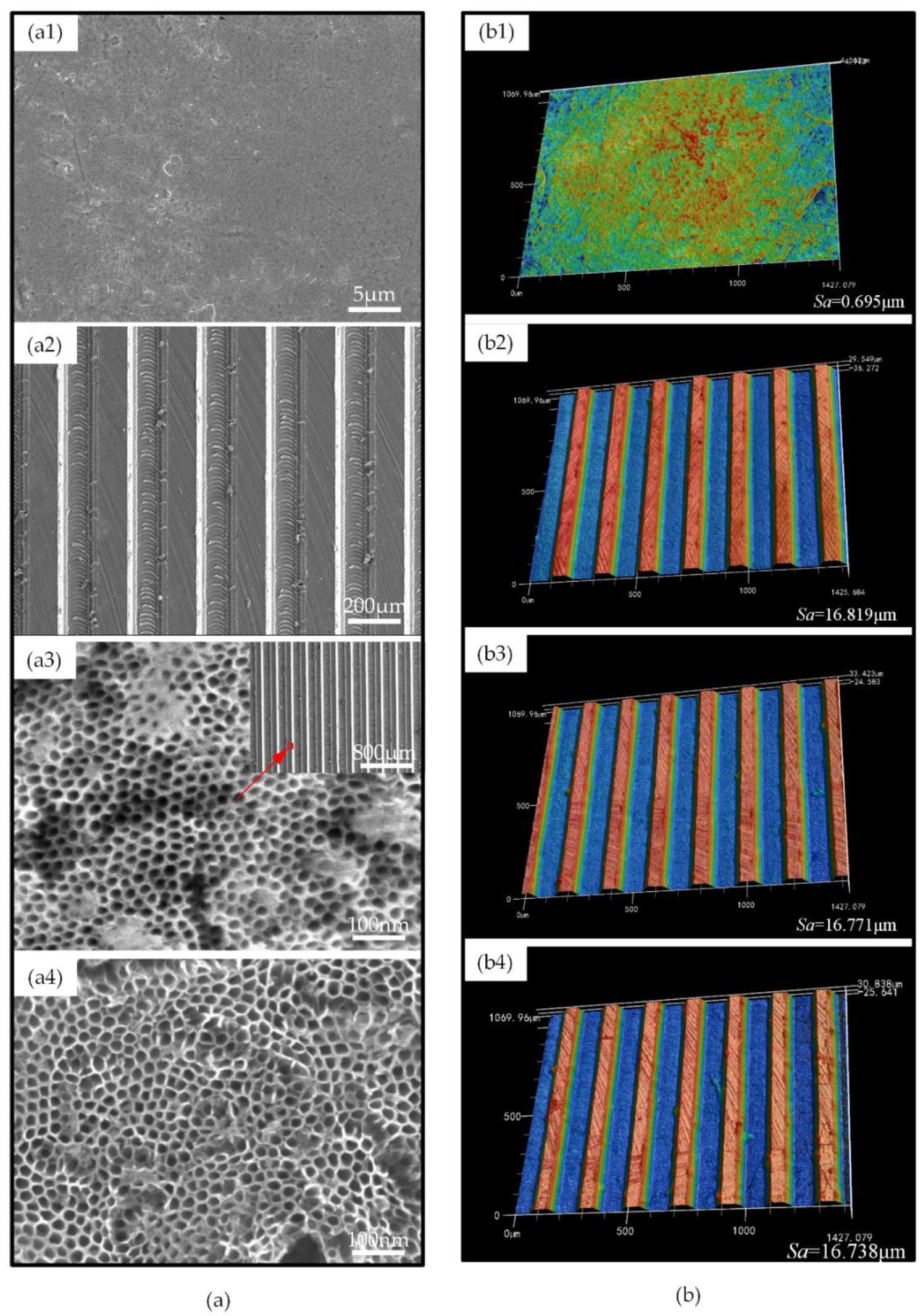
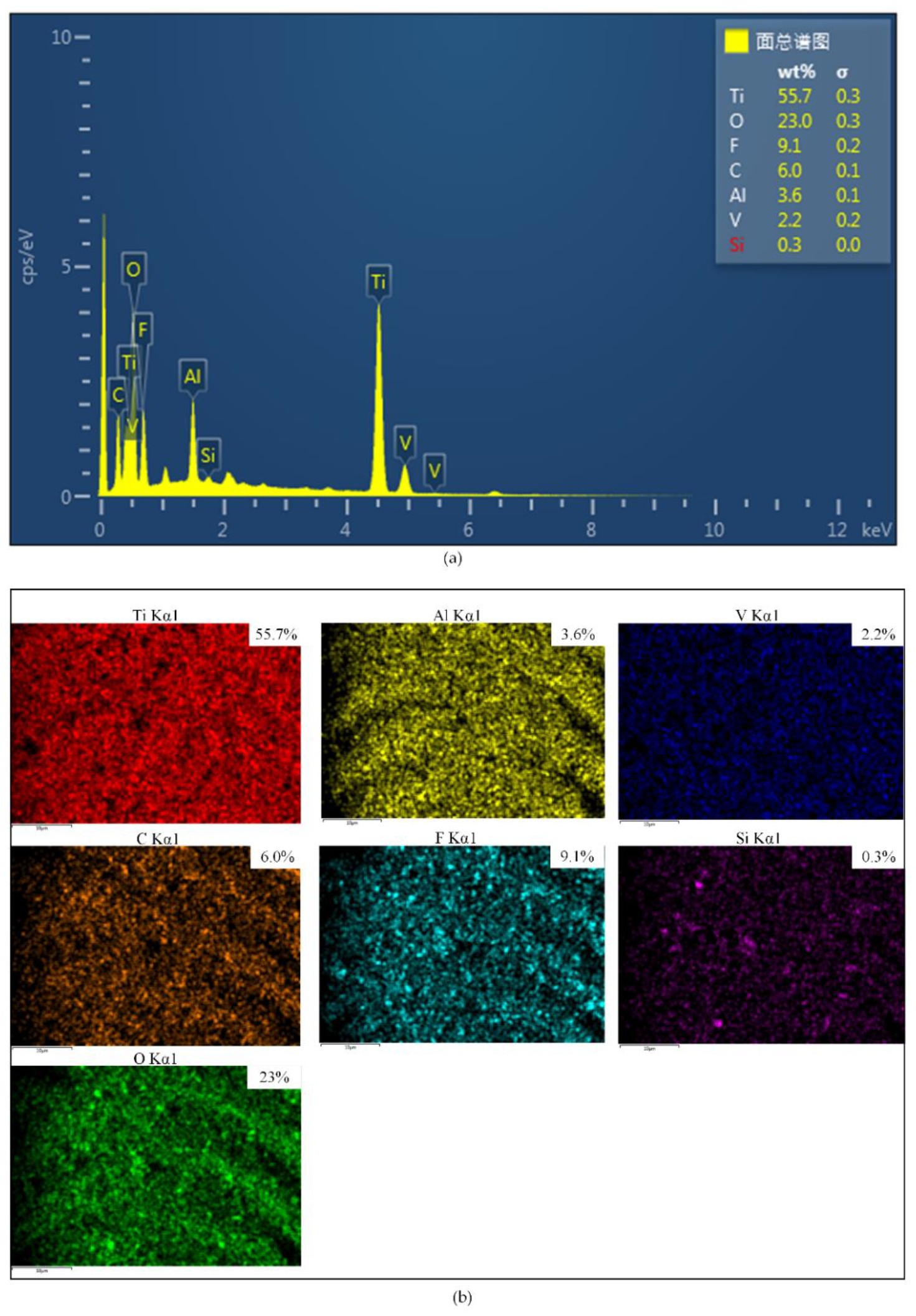


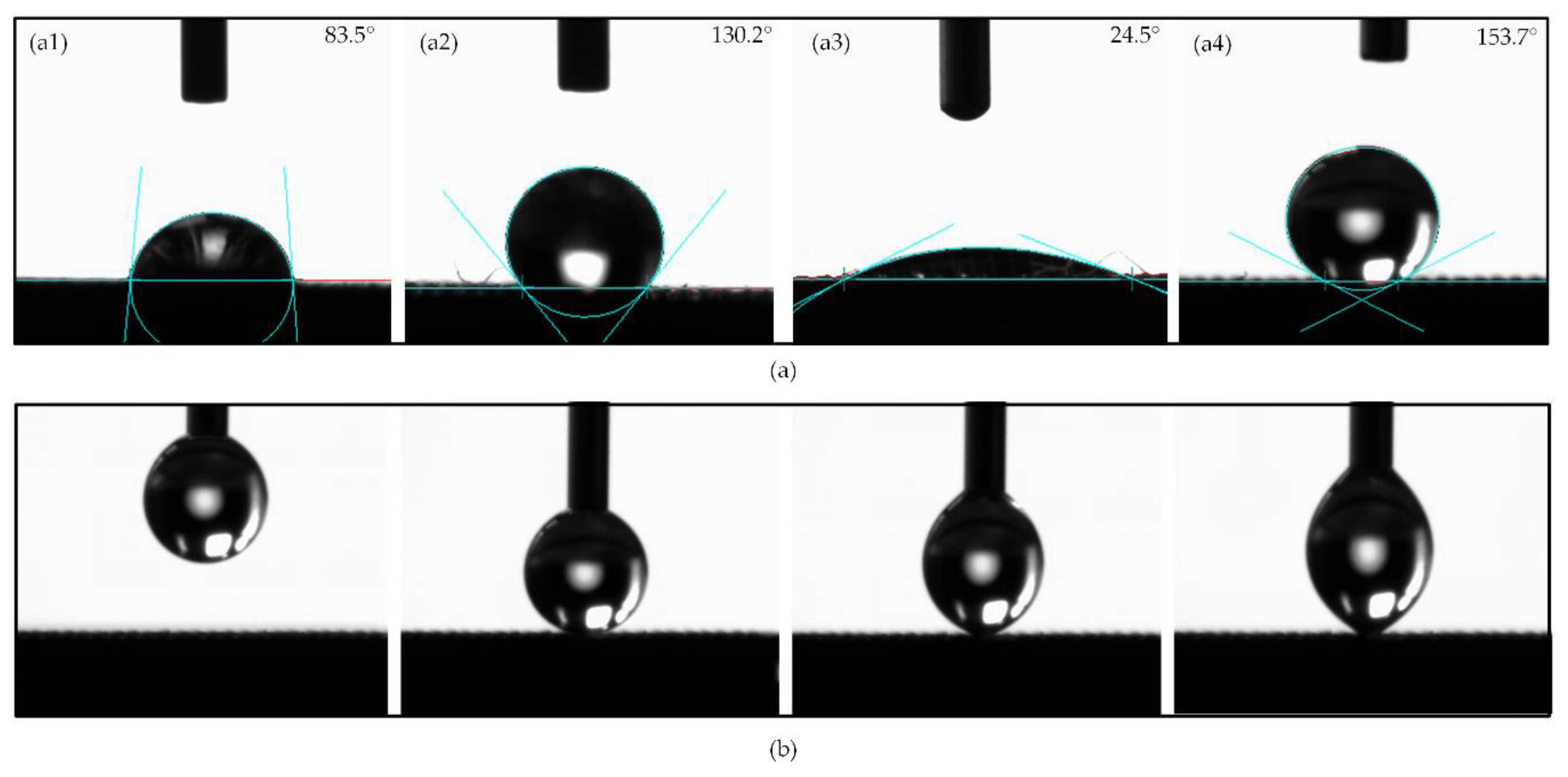
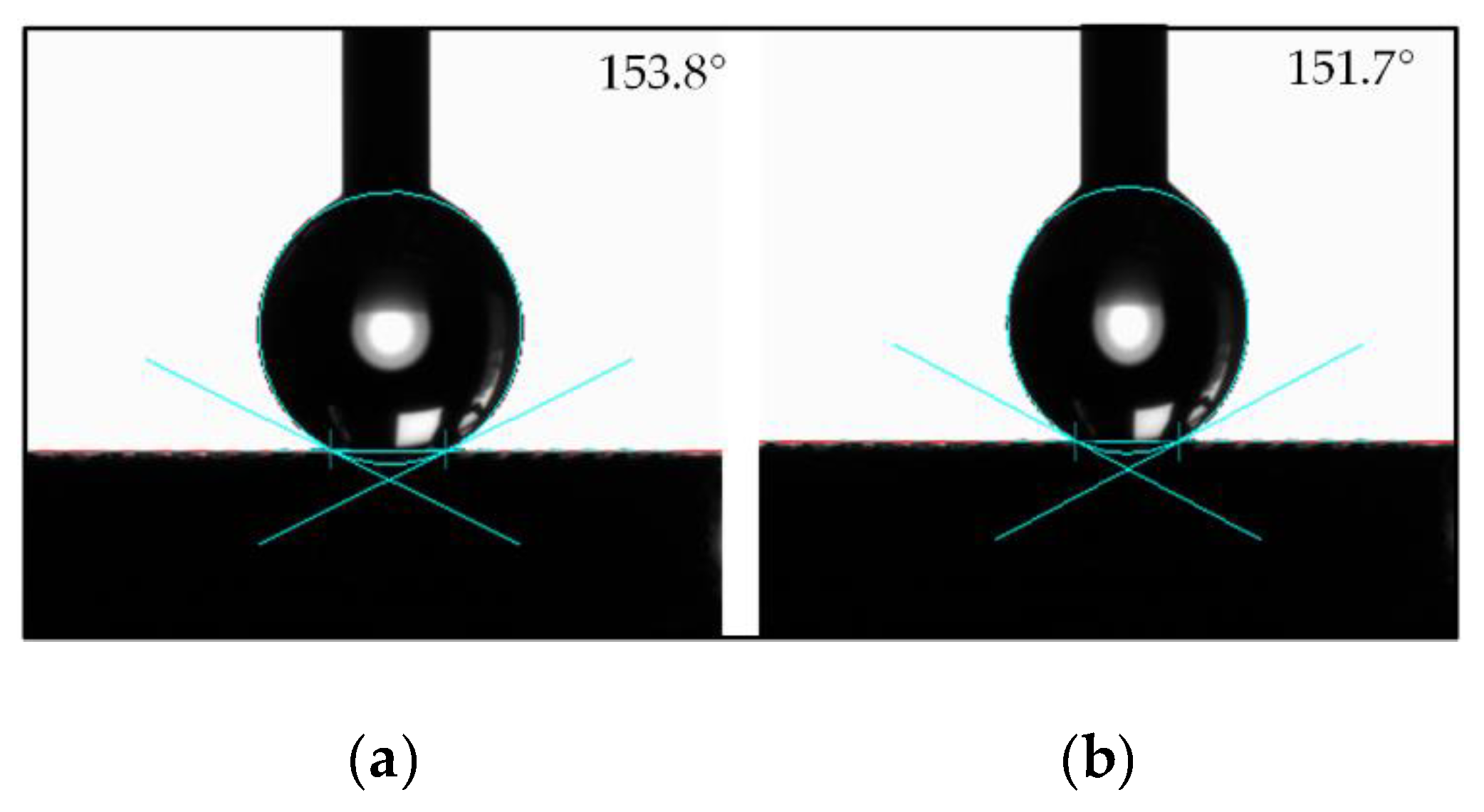
| Spindle Speed (r/min) | Feed Speed (mm/min) | Depth of Cut (μm) |
|---|---|---|
| 30,000 | 100 | 8 |
© 2020 by the authors. Licensee MDPI, Basel, Switzerland. This article is an open access article distributed under the terms and conditions of the Creative Commons Attribution (CC BY) license (http://creativecommons.org/licenses/by/4.0/).
Share and Cite
Zhang, X.; Wan, Y.; Ren, B.; Wang, H.; Yu, M.; Liu, A.; Liu, Z. Preparation of Superhydrophobic Surface on Titanium Alloy via Micro-Milling, Anodic Oxidation and Fluorination. Micromachines 2020, 11, 316. https://doi.org/10.3390/mi11030316
Zhang X, Wan Y, Ren B, Wang H, Yu M, Liu A, Liu Z. Preparation of Superhydrophobic Surface on Titanium Alloy via Micro-Milling, Anodic Oxidation and Fluorination. Micromachines. 2020; 11(3):316. https://doi.org/10.3390/mi11030316
Chicago/Turabian StyleZhang, Xiao, Yi Wan, Bing Ren, Hongwei Wang, Mingzhi Yu, Anqi Liu, and Zhanqiang Liu. 2020. "Preparation of Superhydrophobic Surface on Titanium Alloy via Micro-Milling, Anodic Oxidation and Fluorination" Micromachines 11, no. 3: 316. https://doi.org/10.3390/mi11030316
APA StyleZhang, X., Wan, Y., Ren, B., Wang, H., Yu, M., Liu, A., & Liu, Z. (2020). Preparation of Superhydrophobic Surface on Titanium Alloy via Micro-Milling, Anodic Oxidation and Fluorination. Micromachines, 11(3), 316. https://doi.org/10.3390/mi11030316






